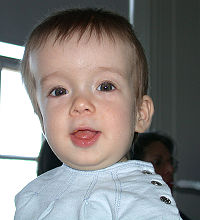
Photo from wikipedia
Nonsyndromic craniosynostosis (NSC) is more common than syndromic craniosynostosis and predominantly involves single suture. It affects sagittal, coronal, metopic, and lambdoid sutures in the decreasing order of frequency. A surgery… Click to show full abstract
Nonsyndromic craniosynostosis (NSC) is more common than syndromic craniosynostosis and predominantly involves single suture. It affects sagittal, coronal, metopic, and lambdoid sutures in the decreasing order of frequency. A surgery for NSC is generally recommended to avoid potential neurodevelopmental delays and sequelae of raised intracranial pressure. Open calvarial vault reconstruction, strip craniectomy with/without the use of a postoperative molding helmet, strip craniectomy with spring implantations, endoscopic suture release, and cranial distraction osteogenesis are various surgical options used for NSC cases. The ideal age for intervention is 6–12 months for open procedures and 3–4 months for endoscopic approaches. The management is directed toward minimizing operative trauma and improving the neurocognitive outcome. The role of nonsurgical intervention by the use of genetic manipulation is still not a reality because of the nature of disease and time of presentation.
Journal Title: Journal of Pediatric Neurosciences
Year Published: 2022
Link to full text (if available)
Share on Social Media: Sign Up to like & get
recommendations!